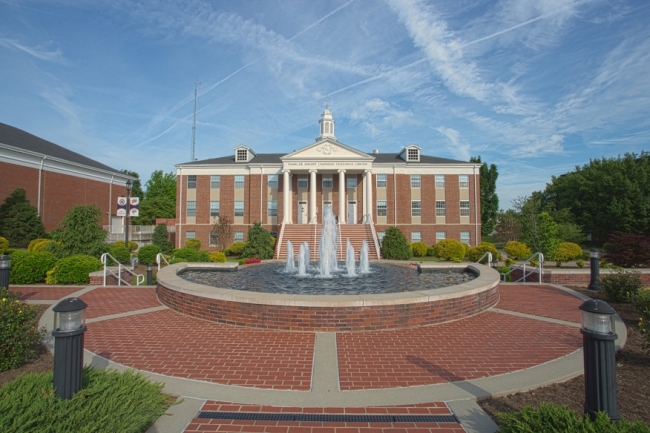You have /5 articles left.
Sign up for a free account or log in.

University of the Cumberlands
In October 2015, James Taylor retired after 35 years as president of the University of the Cumberlands, which at the time was a Baptist institution in Williamsburg, Ky., enrolling about 6,300 students.
Taylor had led the university through significant growth, overseeing it as it changed from Cumberland College to a university, grew its campus and increased its assets. The plan was that he would step down from the presidency and into the newly created role of chancellor. Taylor would live in Florida but assist his successor, Larry Cockrum, “in friend raising and fund raising,” according to an archived university statement.
That arrangement didn’t last long. By spring, Taylor and the university were at odds over the terms of his retirement and whether he should be paid hundreds of thousands of dollars per year in compensation and perks -- for life.
Taylor and his wife say they are covered by a 2012 contract promising them lifetime salary and benefits equal to what he was receiving when he stepped down from the presidency. The university has taken the position that its Board of Trustees was never told about the contract’s details, that its board never approved the contract terms and that the chairman of the Board of Trustees who signed the agreement didn’t have the authority to do so. It also argues the agreement in question does not meet legal requirements for a valid, enforceable contract.
In June 2016, the Taylors sued over the disagreement in U.S. District Court for the Eastern District of Kentucky. Today, after 31 months of often-contentious legal proceedings, the case is scheduled to go before a jury for trial.
The case has drawn attention beyond the borders of Kentucky because it is unusual in the often-opaque fields of private higher education executive compensation, contracts and board governance. Although it’s not unheard-of for presidents or retired presidents to come into conflict with boards over the terms of their compensation packages, few such disagreements end up in court. Most are settled quietly.
Details about the compensation the Taylors say is owed to them are also raising eyebrows.
The 2012 agreement in question provides for the Taylors to receive James Taylor’s yearly salary as president for the rest of his and his wife’s individual lives, along with benefits. Taylor earned $204,875 in base compensation for the last full year he was president, the year ending in June 2015, university tax filings show.
Benefits spelled out in the 2012 agreement for the university to provide include long-term health-care costs, assisted-living facility costs, an apartment or residence for the Taylors in Williamsburg, and a university-provided $200-per-month apartment for Taylor’s brother and sister-in-law, according to court documents. Taylor’s wife, Dinah, was also to be the beneficiary of a university-purchased $1 million life insurance policy.
In return, the Taylors agreed to continue their fund-raising efforts for the university and to serve it “in any capacity requested.” But the agreement also said that compensation and benefits were not conditional upon Taylor remaining president or accepting the chancellor role.
“The compensation and benefits contained in this agreement is/are for the past decades of duties and/or work performed by Dr. and Mrs. Taylor all for the benefit of The University of the Cumberlands,” the document said.
Experts voiced surprise at those terms. In the past it has been common for presidents to receive tenured positions after they step down from leading a college or university. But tenure comes with clearly defined expectations. And that arrangement is becoming less common, said Raymond D. Cotton, a Washington-based lawyer who represents boards and presidents.
“Boards are not going for tenure anymore,” he said. “What they’re going for is faculty appointment for a fixed period of time.”
The amount and type of compensation the Taylors would be receiving has also stood out to those who watch presidential pay. James Finkelstein, a professor emeritus of public policy at George Mason University, studies presidential compensation in higher education, including postpresidential guarantees he and another researcher call platinum parachutes. Finkelstein was contacted by the lawyer representing the University of the Cumberlands about testifying in the lawsuit as an expert but is not doing so.
“As I read through this and compared it to what we know about what we’ve called these platinum parachutes, we’ve never seen anything like the terms of what Dr. Taylor claims to have been approved,” Finkelstein said.
Breach of Contract
When the Taylors filed their lawsuit in June 2016, lawyers representing them wrote that the salary and benefits in question were worth at least $395,000 per year. The suit outlined a series of events beginning in October 2005, when the university’s Board of Trustees allegedly voted unanimously on a postpresidential package for the president and his wife.
The board voted to continue both James and Dinah Taylor’s salary and benefits after he retired from the presidency and to appoint him chancellor, the suit said. James Taylor’s compensation and benefits in effect on the date of his retirement would be continued until his death, and they would continue going to his wife in the event she outlived him.
More than six years later, on April 19, 2012, the Board’s 2005 action was carried out by the execution of a contract, according to the Taylors’ suit. It says the Board of Trustees unanimously approved the agreement, which was signed by James Taylor and Board of Trustees chairman Jim Oaks the same day.
On the day Taylor stepped down as president, the board “unanimously reconfirmed” the university’s commitment to provide a benefits package “to include salary in effect on January 1, 2015, all previously approved insurance for Dr. and Mrs. Taylor, plus all other perks they were receiving,” the suit said.
After Taylor’s retirement, the university offered him a one-year renewable contract at a lower salary, according to the suit. Other court documents indicate that offer was about $152,000 for part-time work.
Taylor turned down the offer.
“He was told if he did not accept this new contract that his relationship with the University would terminate, that no benefits would be paid, and that he would lose the use of a University owned apartment in Williamsburg, KY, the university owned vehicle he drives, and the cellular telephone he uses,” the original lawsuit said. “Despite these threats, Dr. Taylor did not accept any offer from the university for less than he had been previously promised.”
In the summer of 2016, the university acted to sever its relationship with the Taylors, it said in court documents. It discontinued their salaries, Dinah Taylor’s health benefits and mobile phone service for the couple. It later removed Dinah Taylor from the $1 million life insurance policy on James Taylor.
But it did not stop providing the Taylors’ health insurance premiums, the couple’s long-term care insurance premiums, an apartment on campus for the Taylors or an apartment for Taylor’s sister-in-law at below-market rent. Taylor also receives retirement benefits that, combined with Social Security benefits, gave the Taylors at least $175,000 a year, according to the university’s court filings.
When the Taylors filed their lawsuit in June 2016, they alleged breach of contract, promissory estoppel, slander and intentional infliction of emotional distress. The suit also sought punitive damages and reformation of the agreement in question.
About three months after filing the initial complaint, the Taylors amended their suit to include allegations of unjust enrichment and violations of the Employee Retirement Income Security Act of 1974.
Since then, U.S. District Judge Gregory F. Van Tatenhove has issued opinions stripping the lawsuit down to its claim that a contract or agreement has been breached. The judge denied an attempt by the Taylors to amend their suit for a third time and also denied multiple requests by the university to rule in its favor on the breach of contract claim.
That leaves the Taylors saying they had a contract and the university saying the agreement was unenforceable.
“The university claims that the Taylors would receive lifetime salaries and benefits, even if they did not provide any services to the university,” according to an agreed statement of the case filed by both sides in September. “It is the university’s position that the dispute in this lawsuit is whether the University understood, approved, and agreed to pay the Taylors for the rest of their lives if the Taylors did nothing in return. It is the university’s position that the terms of the Disputed Agreement were never presented to or approved by the Board of Trustees, there was never a meeting of the minds, and consequently Jim Oaks did not have authority to sign the Disputed Agreement.”
A lawyer representing the Taylors declined comment and said the couple would not be commenting. The University of the Cumberlands said in a statement that it is looking forward to a jury hearing the case and that it feels confident it will prevail.
“The university asserts that its Board of Trustees never agreed to pay former president Taylor the same salary and benefits he earned as president for the rest of his life, and for the rest of his wife’s life, if Dr. Taylor did no work for the University,” the statement said. “The University remains committed to using its resources for the benefit of students and to fulfilling the mission of providing educational opportunities to people of all backgrounds.”
For the fiscal year ending in June 2017, the University of the Cumberlands collected about $79 million in revenue versus $72.5 million in expenses, federal tax forms show. Its net assets totaled $150.9 million.
Messy Arguments
Recent court filings show lawyers for the university and the Taylors challenging each other’s witnesses and exhibits. They have also outlined the arguments they planned to make in court.
They include arguments over the way the contract was signed, prepared and recorded in meeting minutes. In a pretrial memo, the university argued Taylor alone procured the draft of his retirement agreement from a lawyer without giving the Board of Trustees any opportunity to weigh in on the terms.
Although that lawyer had represented the university regarding planned-giving issues, “he had never prepared any employment contracts for the University,” the memo said. “The University was represented at that time by other counsel, who regularly provided the Board of Trustees with legal advice and services including assistance negotiating and drafting contracts, but that counsel was never consulted regarding the Disputed Agreement.”
The university also argues that Taylor signed his wife’s name on the agreement and that the then board chair, Oaks, ultimately disavowed its terms.
“He repeatedly stated during his deposition that the University never agreed to pay Dr. and Mrs. Taylor a salary and benefits for life if they did nothing in return, and instead insisted that they were to be paid only if Dr. Taylor continued working for the University,” the memo said. “Not only was a copy of the Disputed Agreement never provided to members of the Board of Trustees at or before their April 19, 2012 meeting, but it also was concealed after its execution.”
Lawyers for the Taylors planned to object to any questions suggesting Taylor acted unethically or illegally when signing his wife’s name. There is nothing wrong with signing for a spouse with permission, they wrote in their own pretrial memo.
They argued trustees were justified seeing value from keeping Taylor as chancellor and having his wife as an ambassador. Trustees also had justification to think the couple would contribute to the university after Taylor stepped down from the presidency, according to the plaintiffs’ memo.
“The evidence will have a tendency to show (and will show) that it is highly improbable that Dr. Taylor had the Disputed Agreement prepared and delivered … and then decided not only to not present it to the board for a vote, but instead to conspire with Chairman Oaks (and others) to sign the agreement, falsify the minutes of the meeting, and hide the signed agreement from the University for years,” it said.
Further, the university has not identified anything Taylor did to deceive the board or its chairman, the Taylors' lawyers wrote. They also pointed out that minutes from the April 2012 board meeting indicate a contract for the Taylors was read and approved, and that the board subsequently approved those minutes.
“So far as the events of April 19, 2012, are concerned, the University has not identified anything that Dr. Taylor did to deceive the Board of Trustees or Jim Oaks,” they wrote.
The university maintained no written contract was ever attached to the minutes for the April 2012 meeting. No other trustees that have been deposed or provided affidavits in the case remember Oaks reading a seven-page contract, according to the university’s pretrial memo.
Lawyers for the university questioned the Taylors’ version of the October 2005 meeting where the arrangement originated.
“Minutes state only that the Board of Trustees discussed generally in executive session Dr. Taylor’s retirement and the possibility of him continuing to work in some capacity after his retirement,” the university’s pretrial memo said.
“Dr. and Mrs. Taylor have produced in discovery a second set of ‘closed minutes’ purportedly from a second executive session on October 21, 2005, which contradict the official minutes and handwritten notes from the official meeting,” it said. “According to notations thereon, these ‘closed minutes’ were placed in a sealed envelope kept by Mr. Oaks and not to be opened until authorized by the Board of Trustees.”
Oaks “flatly stated” a second meeting never happened, according to the memo.
Both sides agree that they were unable to reach an agreement in mediation in July. That’s unusual for such a case. They are usually settled out of court, said Michael S. Melbinger, a partner at the law firm Winston & Strawn LLP in Chicago.
“Neither party wants to read their name in the papers,” Melbinger said. “It doesn’t help either one.”
Melbinger’s practice is mostly focused on the for-profit world, but he wrote about the University of the Cumberlands case on his firm’s executive compensation blog in June. He used the case as an example of why lawyers should be sure to follow corporate formalities when preparing compensation agreements.
The case stands out because an executive holding signed documents would generally be considered to have substantial evidence in his or her favor, Melbinger said. Nonetheless, this case has progressed to trial.
“Almost any lawyer representing Dr. Taylor who got all the documents would see this as a slam-dunk case,” Melbinger said. “Yet there is something wrong with it. That’s what’s really unusual.”
Expectations can be different for for-profits and nonprofits, though.
“In the for-profit world, they don’t have the constraints we do,” said Cotton, the lawyer who represents college and university boards and trustees. “In our case, we are regulated by the IRS. You can’t give away the assets of a school and you can’t overpay. They want you to pay market, whatever market is.”




